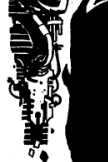 |
||
 |
The Fading Suns Universe |
 |
History
Early in the third millenium, humankind had colonized nearby planets in the solar system, and had finally formed a single, common government, now known as the First Republic.
And, then, two things changed the course of history.
First, in the 24th century, out at the farthest reaches of space, 74 AUs from the sun, humanity discovered an ancient artifact that would later come to be known as a jumpgate. The jumpgate was undenyable evidence of ancient, alien intelligence. It took time to figure out how it worked, but eventually humanity learned how to build ships capable of travelling through the jumpgates into far-away solar systems. Those systems, themselves, had jumpgates to other systems.
The resulting frontier to the stars changed people's perception of humanity's place in the universe. The First Republic dissolved, and an unorganized Diaspora took its place. When the humans discovered the alien Shantor, people questioned long-held religious beliefs about human importance.
People needed something new to believe in. And, in the early 28th century, Zebulon the Prophet filled a void. Like most famous religious figures, Zebulon's exploits have been told, and retold, become larger than life in the process. Even now, even the simplest facts of his existence are hotly contested. Some say that Zebulon was originally a Catholic priest. That he travelled into space in search of knowledge about the builders of the jumpgates. And that, one day, on a frontier world (now long missing), God gave him a vision of the Holy Flame, and of the dark between the stars.
 And
so, Zebulon became the founder of the Universal Church of the Celestial
Sun. He sought to reunite the disparate religions of Earth, using teachings
from many different religious texts. And people began to listen to what
he was saying. It was a time of great change in the Diaspora. The Vau,
a powerful alien race had become displeased with humanity. In 2849,
Zebulon planned a trip to negotiate peace with the Vau and died in a
jumpgate
accident.
A stylized jumpgate has been the symbol of the Universal Church ever
since.
And
so, Zebulon became the founder of the Universal Church of the Celestial
Sun. He sought to reunite the disparate religions of Earth, using teachings
from many different religious texts. And people began to listen to what
he was saying. It was a time of great change in the Diaspora. The Vau,
a powerful alien race had become displeased with humanity. In 2849,
Zebulon planned a trip to negotiate peace with the Vau and died in a
jumpgate
accident.
A stylized jumpgate has been the symbol of the Universal Church ever
since.
Within a few years of the death of Zebulon, the Ukar war broke out. The Church helped to reunite humanity against the Ur-Ukar, and by the middle of the fourth millenium, humanity had formed the great Second Republic.
The Second Republic was a time of incredible advancement. Humans lived in extreme luxury. Technology advanced daily. Genetic engineering and terraforming were exercised with casual ease. Of course it couldn't last.
The first problems were economic. Robots displaced too many workers too quickly. The Republic's welfare system strained under the burden. And then the central computer net was sabotaged by a group of terrorists, unknown to this day.
In the anarchy that ensued, extremely wealthy nobles and powerful corporations both tried to grab power. The nobles negotiated more and more local power from the central government, and the corporations became more and more secretive about technology.
And then people noticed that the suns were fading. The suns had visibly dimmed on several worlds, and people couldn't make sense of it. People talked about the universe coming to an end, and needed someone to blame. The government, the scientists, and technology were popular targets. The Universal Church fed into the cycle of fear. They preached that humanity had become too prideful, and were being punished by the Pancreator for their hubris. There were riots and wars, the likes of which humanity hadn't seen in centuries. It was the beginning of the fifth millenium and the New Dark Ages had begun.
The Dark Ages
It's impossible to say how much was lost during the Dark Ages. Technology (now viewed as contributing to the great Fall) was forgotten. Whole worlds were lost beyond the jumpgates because computers containing vital coordinates were destroyed by angry mobs or Church Inquisitors, or because local governments deactivated their jumpgates.
Some of the distant worlds seemed to revert into barbarism. The remaining Known Worlds were often attacked and invaded by barbarian fleets, and might have fallen if not for Vladimir Alecto, the leader of the noble House Alecto, who managed to restore some semblance of organization. Vladimir was a military genius who lead the Known Worlds against the barbarians. And after finally repelling the invaders, the nobles of the Known Worlds finally agreed to declare Vladimir emperor of the Known Worlds. But Vladimir was murdered on the day of his coronation, and the nobles could not agree on a successor. The best compromise involved a series of regents who would be elected and replaced every 10 years. Regents controlled the Known Worlds for hundreds of years.
In 4956, fifty years after the horrible Symbiot Wars, House Hawkwood, led first Darius Erik Hawkwood and later by his nephew Alexius Hawkwood, attempted to claim the title of Emperor. The Emperor Wars lasted for almost forty years, and in 4993, Alexius became the first emperor of the Known Worlds since Vladimir's fateful coronation.
Emperor Alexius had to make certain promises to various other faction. He guaranteed that the Orthodox sect of the Universal Church would represent the official religion of the Known Worlds (an act which won the backing of the church and of their noble allies, House Li Halen). He allows the Merchant League to control certain worlds and maintain their monopoly on technology.

Fading Suns is a trademark and copyright of Holistic Design Inc. The mention of or reference to any companies or products in this site is not a challenge to the trademarks or copyrights concerned.
The HERO System and all associated games, game products, terms, and images are copyright © 2009 by DOJ, Inc.
All other text, copyright © 2004-2009 by B.C. Holmes. Return to the index.